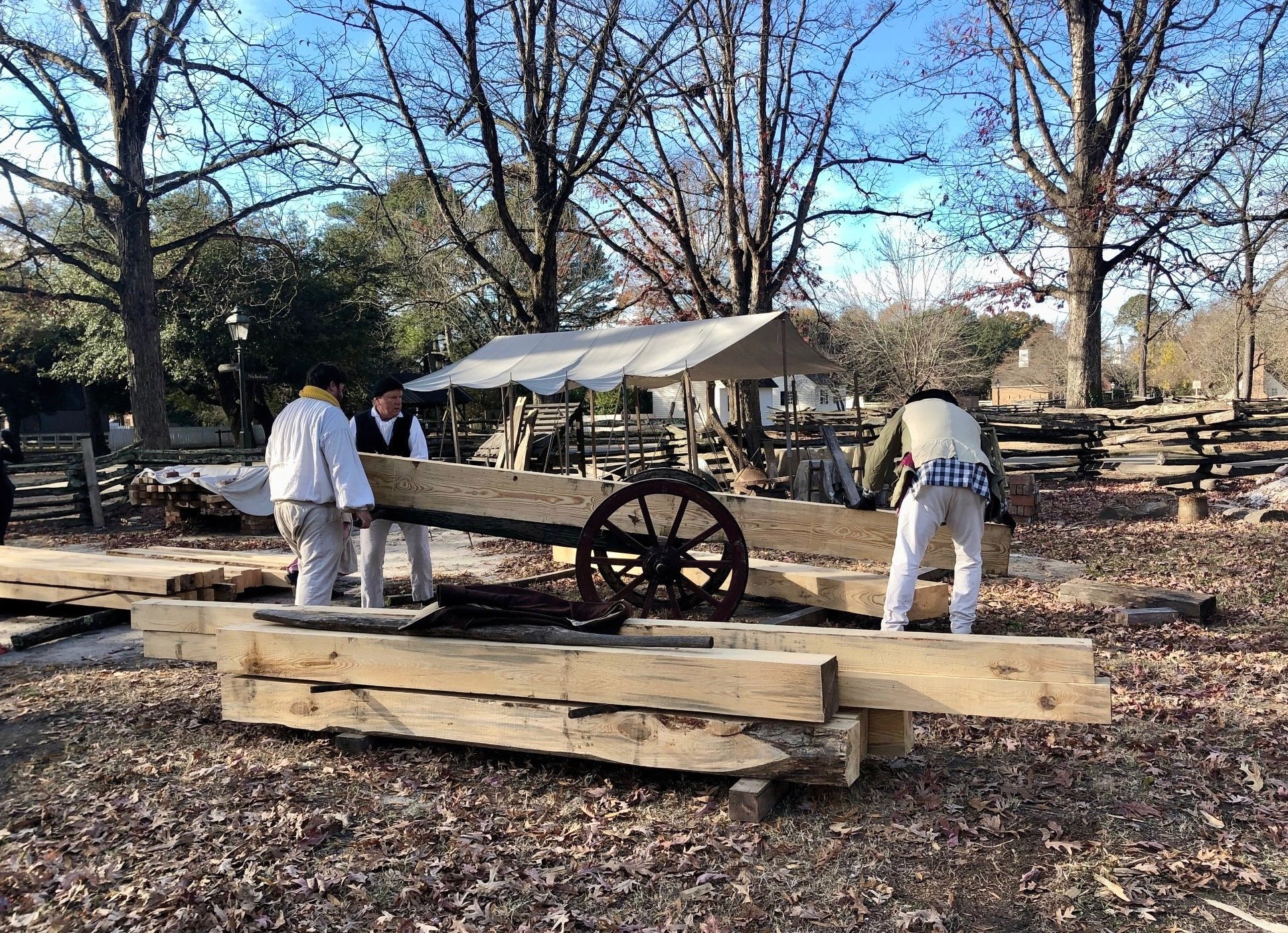Good day dear friends,
One week ago this morning, Ryan Penner delivered his first load of cut timbers to the carpenters yard here at Colonial Williamsburg. It took seven strong-hearted souls an hour to unload the heavy timbers, among which, the sills and plates alone weighed over five hundred pounds apiece. No weight could prevail against the high spirits of those souls, however, and the work was undertaken and finished with the good cheer of expectation. And the expectation was for work.
The minute Ryan's truck drew up to the yard, apprentice carpenter Matt Sanbury took charge. Matt is one of Garland Wood's crew of carpenters, and our frame is his journeyman's project. An apprentice in any one of Colonial Williamsburg's two dozen historic trades must pass through five stages of demonstrated competence before they are offered the opportunity to undertake a journeyman's project. For the historic carpenters, that final project is always building a frame.
The historic tradespeople here are a most unusual lot, who have made a lot of most unmodern choices. They have chosen passion over prestige, meaning over money, permanence over passingness. They have chosen a unity of hand and mind over all the advantages of fragmentation. In their commitment to seek out and embody the archetypal roots of material craft, they have chosen the timeless over time.
Matt is such a person. Before he came to Williamsburg five years ago, he was for ten years a farmer, a cooper, and coordinator of trades at the Genesee Country Village and Museum, the largest living museum in the state of New York. Matt grew up on a family farm, where the principal produce was tree fruit for preserves. You learn lessons about life on a farm, teachings largely forgotten in our time. As Aldo Leopold observed, "There are two spiritual dangers in not owning a farm. One is the danger of supposing that breakfast comes from the grocery, and the other that heat comes from the furnace.”
In that way, one might say that the historic trades at Williamsburg stand as a bulwark against the spiritual dangers of ungoverned modernity. Not that the tradespeople themselves ever speak in that highfalutin way. But they often exemplify it.
I was at the tinsmith's shop with some visiting guests the other day. One of the tinsmiths was speaking about his hunger for meaning, and the ways in which even a quite specialized trade like his opens up a window on the complex interconnectedness of things. He was working on a lightweight tin stove that day. You begin with a stove, you work your way backward to tools and hands, to mining and smelting and mineralogy. You work your way forward to labor and pay, to war and peace, to international trade networks, to political parties, to freedom and slavery and conscription, to the philosophy of history, to a whole world lit only by fire.
Among the carpenters, Matt is a passionate collector and connoisseur of traditional tools. He studies the tools he collects, and fashions many of his own tools for use in his trade. He demonstrated to me yesterday how different tools serve often very subtly different purposes, and how each individual leaves the marks of their individuality on their tools in everything from habits of daily care to finger grooves to patterns of use. If the hand is the cutting edge of the mind, I see now how the tool is the cutting edge of the hand, and the crafted object the cut edge of an infinitely complex web of material, cultural, and spiritual relations.
The same day the timbers were delivered, Matt had them sorted into building sections and ordered for priority. In the relatively uniform world of modern building materials, one does not think much about prioritizing posts and beams. But in a life lived much closer to nature than we mostly live today, nothing is truly uniform. Everything has individuality. And not merely the individuality of "self-expression," which seems a pretty insubstantial thing when you're hoisting five-hundred pound beams, but the individuality imparted by nature and iron necessity.
The oak trees from which Ryan expertly wrested our sill beams were in some cases so barely sufficient that their narrow ends were very irregular. You would hardly accept them from a lumber yard. But modern lumber yards work upon principles of abundance and uniformity. Ryan and we are committed to making the most of necessity. Those "wany" timbers were only fit for the "male" tenoned sills, with the more substantial ones reserved for the load-bearing "female" mortised beams. The five principal posts were likewise distributed into their various places according to their regularity, the most irregular put into private corners, the very best at the public front door.
Over the course of the early week, the sill beams were jointed and drilled—all with period hand tools—and laid down just above ground level. The minute they went down, the crowds of visitors poured in. What is this going to be? What is it for? How does it work? When will you finish? I was amazed at such a reaction to so lowly a start. Even the children seemed to sense that this was a house destined to revisit the sacred beginnings.
Then the sill beams were lap-jointed and the floor joists laid in. That work was mostly done when the yard closed last evening. Today the joists were finished and corner posts begun. Matt supervises everything, lays everything out, checks everything, and does much of the work. For the length of the frame-building project, he is the apprentice-master in charge. His inexhaustible high spirits make every operation a kind of lark, while remaining an exercise in strength and craftly precision.
These are the hands upon which the world has always depended for shelter and survival. Whether they be weaving marsh reeds into mats to clad a yehakin, packing mud and stone into circular walls to form a rondavel, or chamfering timbers to refine a farmer's one-room house, we can only live as well as our homes permit us. "First we shape our buildings, thereafter they shape us." So may it be.
Yours with pleasure,
Michael
The Innermost House Foundation remains an entirely volunteer organization,
dedicated to renewing transcendental values for our age.
IMAGES
D. Lorence: Matt Sanbury
M. Lorence: Crew unloading first timber at the carpenters yard
D. Lorence: Matt Sanbury marking out wany timber



